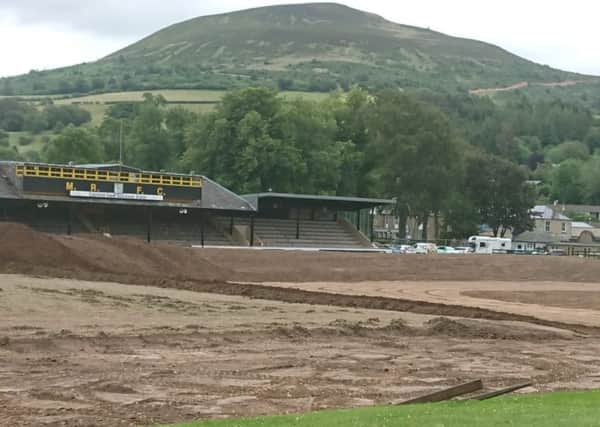Scotland legend Craig Chalmers’ dismay as Melrose pitch is ripped up for 3G surface


The sight of tractors ploughing up the home of Sevens has been an emotive one and, although not completely out of the blue as it was always going to be a part of the club’s move to join the new part-time professional Super 6 set-up, it has still come as a shock to a town where the rugby pitch is integral to the very fabric of its soul.
The phrase “hallowed turf” may be melodramatic but shouldn’t be discounted as without tradition sport just becomes a day-to-day activity full of motion but lacking in meaning.
Advertisement
Hide AdAdvertisement
Hide AdChalmers, one of the fabled heroes of 1990, is Melrose through and through, starting his playing career in the 1980s and going on to coach the hometown club he loves.
“The Greenyards is my home and it breaks my heart to see it ripped up like that. And all for what? A competition that probably isn’t going to last,” said the 50-year-old former stand-off, who won 60 Test caps for Scotland and one for the British and Irish Lions in 1989.
Chalmers admits that much of his response is down to sentiment but he also has genuine concerns about the safety of playing rugby on plastic pitches. He accepts that a new artificial surface, along with floodlighting, opens up the opportunity for greater community access but questions why it has to be on a main pitch which is the heart and soul of the community, fenced off, with Live Borders, the leisure arm of Scottish Borders Council, as landlords seeking to make a profit.
The finances behind the project are unclear. The Scotsman made a number of attempts yesterday to get to the bottom of who exactly is funding a £1.1 million project which, even with recoverable VAT, is set to come in at just under the million mark.
Scottish Borders Council admitted it has pledged up to £600,000, while the SRU vaguely admitted that it was spending over the usual cap of £50,000 available to members from its £400,000-a-year “club sustainability fund”.
An SRU spokesman said that, in view of of the public sector investment, it made “business sense” from a point of view of growing rugby that further investment was made by the union in the project.
Melrose RFC, historically regarded as one of Scotland’s richest rugby clubs due to their famed annual sevens tournament, would not reveal how much they were contributing. A Greenyards insider told The Scotsman that it was a fluid arrangement, initially floated as a “third-third-third” deal between club, public sector and SRU, which the club part accepted as being “on the hoof” in terms of fundraising.
A Melrose spokeswoman said: “Melrose Rugby Ltd are very happy to be working with our funding partners to deliver a 3G community pitch. The new facility will be for the use of our players from P1 to senior teams, and other local sports clubs and schools across the Borders.”
Advertisement
Hide AdAdvertisement
Hide AdAs for Chalmers, and many in Melrose, there is a sense of sadness at seeing the pitch he forged his sporting life upon being torn up.
An online petition, set up in the name of “Ned Haig”, the inventor of sevens rugby, is ticking up signatures and prominent local sponsors and backers of the club have been making their dissatisfaction clear. The Greenyards was bequeathed to the town by the Ormiston Trust, which will now be overseen by the council on the behalf of Melrose Rugby Ltd, the new entity managing the Super 6 franchise.
A Scottish Rugby spokesman said: “The development of The Greenyards ground in Melrose is an exciting local initiative led by Scottish Borders Council and Melrose RFC and forms part of the club’s own long-term legacy project.
“Scottish Rugby has been requested to support the project. It is expected, based on the proposals from Scottish Borders Council and Melrose RFC, that there will be an increase in playing opportunities and wider community use. It’s noted that Scottish Rugby is a minority contributor to the overall project and this builds on involvement with other capital projects to develop new facilities at clubs across Scotland.”
Chalmers, meanwhile, has been active on Twitter showcasing what he views as the dangers of artificial surfaces and, in recent weeks, there has been concern expressed by the English Rugby Players Association, which has called for a moratorium on plastic pitches after what it describes as spiralling injury rates.
“Yes it is sentiment to a degree,” said Chalmers. “But I also hate these plastic pitches. They cause injuries and they’re not a true surface. This is the home of Sevens, it shouldn’t be happening.
“The Greenyards was a great grass pitch, not flawless, but still excellent and well looked after. If this Super 6 thing has to be done then why not put in a lot less money to make a good grass pitch an even better grass pitch.”
Last year players from Welsh club Scarlets were scathing about the 4G surface at Scotstoun during the Guinness Pro14 semi-final against Glasgow, which saw Scotland flanker John Barclay, inset left, sustain a long-term Achilles injury.
Advertisement
Hide AdAdvertisement
Hide AdAs part of the franchise deal for Super 6, which is due to launch this November involving Melrose, Ayr, Boroughmuir, Watsonians, Heriot’s and Stirling County, all clubs are bound to have a 3G pitch in place within five years.
A Borders Council spokesperson added: “The pitch will comply with World Rugby and FIFA regulations and will require to pass laboratory and field tests – including a head injury assessment – before it is allowed to open for use.”